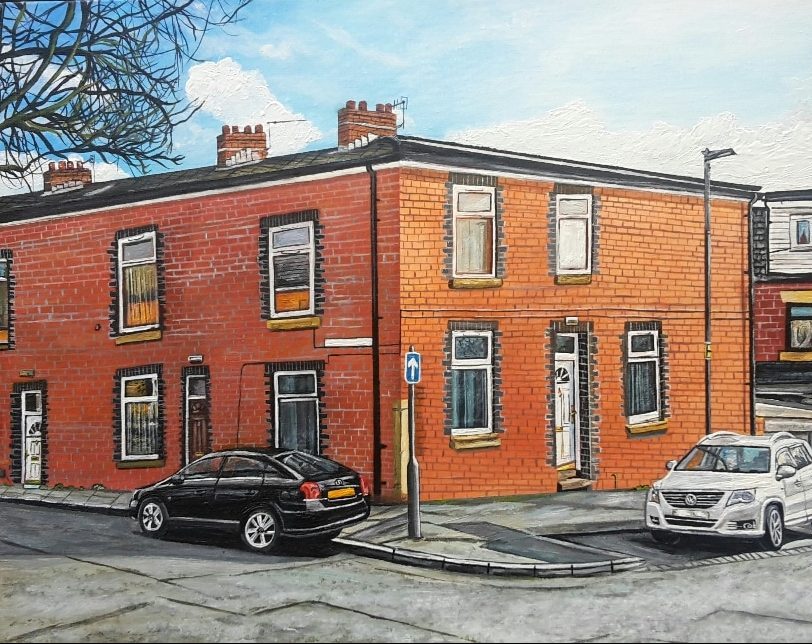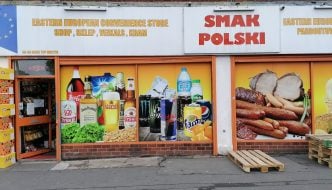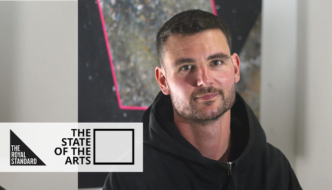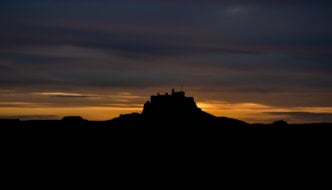“We need an accurate picture of towns like Blackburn” – painter Saima Hussain on community
May 14, 2020

Saima Hussain is a painter based in Blackburn, Lancashire. She has been commissioned by Kick Down the Barriers, a project aimed at challenging misconceptions about Blackburn in the mainstream media. Before lockdown, she ran a popular series of streetscape workshops, and is continuing to use her paintings to engage with her community during the COVID-19 crisis.
How did you get into streetscape painting?
I took A-level art at Blackburn College. Landscapes were my comfort zone – waterfalls, that kind of thing. In high school I had a lot more freedom to explore, whereas in college you have to stick to this one certain thing. For this one module we had to draw buildings. The teacher made me take photos of the buildings and paint from them and soon I was really enjoying it and started doing more at home.
I didn’t do art at uni! I have a degree in law. People are always surprised. I like law and I like art. Why does it have to be one or the other? I don’t want to stick in one box. I painted my way through my degree, in any spare time I could get, it was very therapeutic. I took commissions, but I limited them so I could handle my studies as well. After my undergraduate degree I did a postgraduate diploma in legal practice. Alongside my artwork I’m now looking for jobs in law as well.

Talk me through the process of painting a streetscape.
I use acrylic on canvas, or occasionally in a sketchbook, I’ve painted on the smallest canvases you can think of, to the largest. My commissions tend to be from local people. One of the law teachers in college is the biggest reason I pursued art – she told me not to forget about the art side even though I was pursuing law.
I’ve exhibited work at the Harris Museum in Preston and I’ve also had a solo exhibition at Darwen Library. My teacher pushed me to exhibit work. She’s amazing and exhibitions are a big motivator.
I work from photos, I ask my neighbours if it’s OK to put their cars in. I start off with pencil drawings, and then paint in the base colours, the main colours I can see. I work from dark to light, beginning with the shadows and then adding detail, layering light over the top. I create textures with layers of paint. At the end I step back from the canvas and come back to it the next day with fresh eyes.
What’s your ideal audience for your work?
I’ve lived here in Audley Range my whole life, so it’s really familiar to me. I like showing people the place where I’ve grown up. There are lots of things in Audley to paint: mosques, churches, grocery stores…
I definitely want people outside of Blackburn to see Audley for what it is. We have our good things – like the mosque and churches and what they do for the community. St Joseph’s church hall hosts weddings for Asian and Muslum families too. I’ve been there myself to a couple of neighbours’ weddings, or mendhi functions.

Tell me about your streetscape painting workshops. How are you doing these remotely?
The workshops were amazing, they were so fun. I printed out photos I took of Audley. I prepared a piece at home that showed the breakdown of a painting with each step – pencil drawings, blocks. I helped people with blending and tricky bits like tree trunks.
There were people from all ages and backgrounds: a couple of teens, people from Age UK, everyone really enjoyed themselves. One lady was there every week without fail, she brought me a book of photographs of trees, because she knows I like trees.
Now that in-person workshops aren’t possible, I’ve invited people living in Audley Range to send pictures of the views from their windows. I’ll be choosing a couple of photographs to paint. It means I’ll still have that social connection with people. When everyone was picking up food before the start of lockdown, I was stockpiling art supplies.
In some ways my art is perfect for lockdown. I don’t include many people or figures, and the view from the window shows a weird calmness or stillness, it’s like I’m painting a ghost town.
Why are projects like Kick Down The Barriers important to places like Blackburn?
We need a more accurate picture of towns like Blackburn. Documentaries like Panorama are so negative and biased. Kick Down The Barriers doesn’t just take one angle, but explores communities by engaging with people from different ages and backgrounds for a larger range of stories and viewpoints.
Kick Down The Barriers has allowed me to get to know people who live in the Audley area who I wouldn’t normally. I’ve met two lovely ladies who go to the ARC refugee and asylum seeker centre – they were really interested in my paintings.
What have been your experiences of Blackburn during lockdown?
It’s Ramadan at the moment. Usually our local stores are packed, and now they’re empty. Our mealtimes have been adjusted and our sleep schedules are all over the place.
Ramadan has a different feel to it this year. There is always an atmosphere in the streets after evening prayer. Even just sitting in your living room with the window open, you could hear the liveliness outside. That’s all gone now. We often have Eid prayers in the park but that won’t be happening this year. I’m still planning to eat together with my cousins at Eid, on a video call. We’ll still get dressed up and make the most of it as much as we can.
Even when we come out of lockdown, there will be a lot of uncertainty and apprehension. We won’t spring back to normal with the hustle and bustle. We need to hold on to hope and community spirit.
Filed under: Art & Photography
Tagged with: blackburn, city, community, engagement, kick down the barriers, mainstream, media, misconception, painter, paintings, Saima Hussain, streetscapes, Workshops



Comments